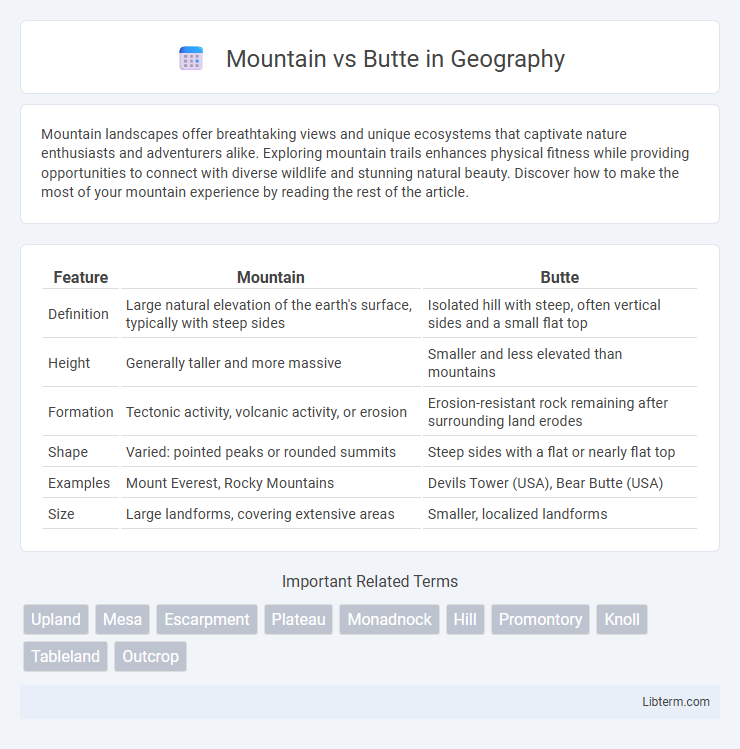Mountain landscapes offer breathtaking views and unique ecosystems that captivate nature enthusiasts and adventurers alike. Exploring mountain trails enhances physical fitness while providing opportunities to connect with diverse wildlife and stunning natural beauty. Discover how to make the most of your mountain experience by reading the rest of the article.
Table of Comparison
| Feature | Mountain | Butte |
|---|---|---|
| Definition | Large natural elevation of the earth's surface, typically with steep sides | Isolated hill with steep, often vertical sides and a small flat top |
| Height | Generally taller and more massive | Smaller and less elevated than mountains |
| Formation | Tectonic activity, volcanic activity, or erosion | Erosion-resistant rock remaining after surrounding land erodes |
| Shape | Varied: pointed peaks or rounded summits | Steep sides with a flat or nearly flat top |
| Examples | Mount Everest, Rocky Mountains | Devils Tower (USA), Bear Butte (USA) |
| Size | Large landforms, covering extensive areas | Smaller, localized landforms |
Defining Mountains and Buttes
Mountains are large landforms that rise prominently above their surroundings, typically featuring steep slopes, significant elevation, and a well-defined peak formed through tectonic forces or volcanic activity. Buttes are isolated hills with steep, often vertical sides and a flat or gently rounded top, significantly smaller than mesas, created primarily through erosion processes. While mountains are expansive and complex structures, buttes are relatively small, erosion-resistant remnants standing solitary in a landscape.
Geological Formation Differences
Mountains form through tectonic forces such as the collision, folding, and faulting of Earth's crust, resulting in large elevations with complex structures. Buttes develop primarily by erosion, where softer rock layers wear away, leaving a small, isolated hill with steep sides and a flat top composed of harder rock. The key geological difference lies in mountains originating from internal geodynamic processes, whereas buttes are shaped by external erosional forces.
Key Physical Characteristics
Mountains are large landforms that rise prominently above surrounding terrain with steep slopes and significant elevation, often exceeding 1,000 feet (300 meters) in height. Buttes are isolated hills with steep, often vertical sides and a flat top, typically smaller than mesas and mountains, usually formed through erosion. While mountains may have rugged peaks and extensive ranges, buttes stand alone and have a distinct flat summit separated by sharp escarpments.
Location and Distribution
Mountains are prominent natural elevations found worldwide, commonly located within mountain ranges such as the Rockies in North America or the Himalayas in Asia, often spanning multiple countries. Buttes are isolated hills with steep, often vertical sides, primarily occurring in arid regions like the southwestern United States, including Arizona and Utah. The geographical distribution of mountains tends to be broader and more varied, whereas buttes are localized landforms typically formed by erosion within specific desert or semi-arid terrains.
Height and Size Comparison
Mountains are typically much taller and larger than buttes, often rising thousands of feet above the surrounding landscape, with the average mountain height exceeding 1,000 feet (300 meters). Buttes are smaller, isolated hills with steep, often vertical sides and a flat top, generally measuring less than 1,000 feet in height. The key distinguishing factor is the extensive size and elevation of mountains compared to the relatively modest scale of buttes.
Common Examples Around the World
Mount Everest in the Himalayas stands as the highest mountain globally, showcasing classic mountainous features with its towering elevation and rugged terrain. Devil's Tower in Wyoming is a prime example of a butte, characterized by its isolated, flat-topped prominence rising sharply from the surrounding landscape. Other notable mountains include Kilimanjaro in Tanzania and the Rockies in North America, while iconic buttes such as the ones found in Monument Valley, Arizona, highlight the distinct geological formations shaped by erosion.
Erosion and Weathering Processes
Mountains form through tectonic forces lifting large landmasses, where intense weathering and erosion gradually wear down peaks over millions of years, shaping jagged ridges and valleys. Buttes result from differential erosion, where softer rock layers erode more rapidly than harder caprock, leaving isolated, steep-sided hills with flat tops. The dominating geological processes for mountains are prolonged uplift and erosion, while buttes primarily develop through selective erosion and weathering of sedimentary layers.
Ecological Significance
Mountains support diverse ecosystems due to their large elevation gradients, creating various microclimates that sustain specialized flora and fauna. Buttes, with their isolated, flat-topped landforms, often serve as refuges for endemic species adapted to limited soil and moisture conditions. Both landforms play vital roles in regional biodiversity and habitat connectivity, influencing ecological resilience and species distribution.
Cultural and Historical Importance
Mountains often hold profound cultural significance as sacred sites in indigenous traditions, symbolizing spiritual connection and ancestral heritage. Buttes, rising sharply from surrounding plains, frequently served as landmarks for navigation and territorial boundaries in Native American history. Both formations are woven into local folklore and continue to influence cultural identity and historical narratives.
How to Distinguish Mountains from Buttes
Mountains are typically larger landforms with significant elevation, extensive slopes, and rugged terrain, often formed through tectonic forces or volcanic activity. Buttes feature isolated, steep-sided hills with a flat or rounded top, resulting from erosion processes that leave harder rock layers standing. Distinguishing mountains from buttes involves assessing size, shape, and geological formation, where mountains surpass buttes in height and overall mass, while buttes remain relatively small and sharply defined.
Mountain Infographic

 libterm.com
libterm.com